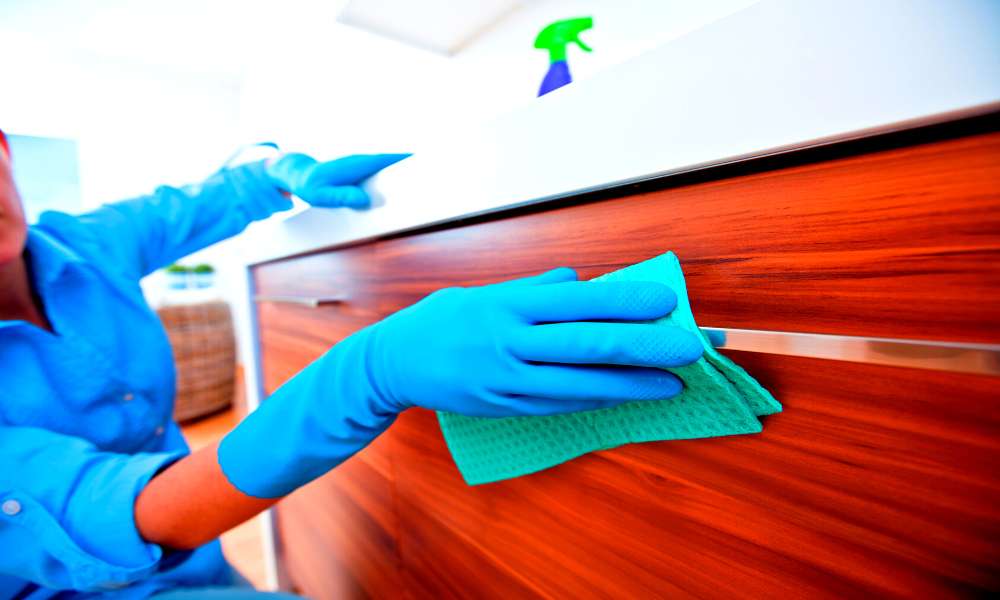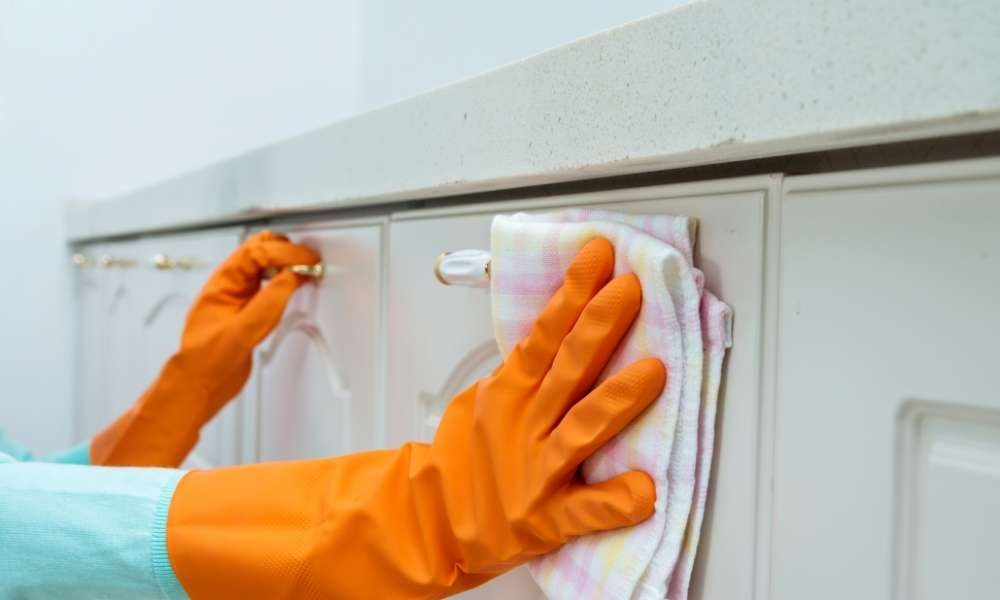If you’re looking for the best way to clean kitchen cabinets with grease, we’ve got your back. Cabinet cleaning is a dirty job, but somebody has to do it! Depending on how bad the grime is on your kitchen cabinets, there are several different options you can use to remove the grease – from products you likely already have in your cupboard to store-bought products that will produce better results. If you’re looking for a quick way to get rid of dirt and grease on your kitchen cabinets, this article is just what you need. Read on and find out more about how to clean greasy kitchen cabinets.
Why Should You Clean Greasy Kitchen Cabinets?

If you’re like most homeowners, your kitchen cabinets are a mess. They are a catchall for everything from dirt and grease to crumbs and other food particles. And while you might not spend much time in your kitchen, it’s important that you take the time to clean greasy kitchen cabinets. Here are some good reasons why:
1) It makes your home look better. Cleaning greasy kitchen cabinets will leave them looking new again, making the space more pleasant for guests and family members alike. Read on to find out how!
Remove Grease From Kitchen Cabinets With These Products
There are several different products you can use to remove grease from kitchen cabinets.
Here is a quick list of some of the most popular products
- Baking Soda
- White Vinegar
- Lemon Juice
- Oven Cleaner
- Coffee Grounds
All these items are inexpensive and easy to find, and they all work well in removing dirt and grime from greasy kitchen cabinets. Let’s explore the pros and cons of each option.
Dish Soap and Water
This is a very simple and easy way to get rid of grease on your kitchen cabinets. All you need for this method is dish soap and water (so make sure to have some on hand). Simply mix the two together, then use a sponge or cloth to wipe down your greasy kitchen cabinets. You’ll be amazed at how well it works – and how little time it takes. If you don’t want to invest in store-bought products, try this solution first! It’s the cheapest option, too.
Baking soda
Clean kitchen cabinets with grease. Baking soda is one of the simplest and most affordable ways to remove dirt, grease, and grime from your kitchen cabinets. Simply sprinkle baking soda on your cabinets. Use a sponge or scrub brush to gently wipe away dirt, grease, or grime. You can also use a wet cloth instead of a sponge or scrub brush. You have a particularly tough surface to clean.
Vinegar and Water
Clean kitchen cabinets with grease. One of the most common ways to clean greasy kitchen cabinets is by using vinegar and water. To do this, grab a bucket and fill it with about 1/4 cup of white vinegar. Pour in enough warm water to fill the bucket three-quarters of the way up. Mix with a spoon, then use a sponge or cloth to wipe your kitchen cabinets down. After cleaning with this method, dry off all surfaces with a towel and enjoy your squeaky clean kitchen cabinets!
White Vinegar and Baking Soda
You likely have both white vinegar and baking soda lying around the house. These are two of the most common cleaning products. They work to remove grease and dirt on kitchen cabinets or any surface in your home. Mixing the two together creates a powerful cleaning solution that will easily clean off the grease on your kitchen cabinets.
Mix one cup of white vinegar with one cup of baking soda in a small bowl. Make sure it is mixed well so that you can’t see any clumps of baking soda left over. Dab some onto a cloth (a rag will work just as well) and apply it to your dirty kitchen cabinets. Rub it into the surface with circular motions, then use a damp cloth or paper towel to wipe off what was loosened by the mixture. This should take care of any grease stains on your cabinet doors or surfaces, but if you want to do an even better job, you can repeat this process until all traces are removed from your cabinets.
Lemon Juice and Baking Soda
Cleaning greasy kitchen cabinets with lemon juice and baking soda is one of the easiest ways to go about it. All you need to do is mix the two ingredients together, in a 1:1 ratio, and use a small piece of cloth or paper towel to apply the solution to the grease on your cabinets. Let it sit for five minutes, then wipe it off with another cloth or paper towel. The baking soda will act as an abrasive agent against the grease, while the lemon juice will help remove any dirt stuck to your cabinets – plus it smells great too!
Lemon Juice and Salt
Clean kitchen cabinets with grease. One of the most effective ways to remove grease from your kitchen cabinets is with a mixture of lemon juice and salt. The acidic properties in the lemon juice will help break down the grease. Salt acts as an abrasive cleaning agent. Just mix equal parts of each ingredient in a bowl or pot. Apply generously to the greasy surface you’re working on.
Lighter Fluid
If you have a light layer of grease on your kitchen cabinets, consider using lighter fluid. Lightly coat the surface with the fluid and let it sit for a few minutes before scrubbing it with a brush or sponge. Be careful not to use too much lighter fluid, because it can easily get carried away and cover too much area in one go. For tougher stains, you’ll need to scrub vigorously to remove them.
Clean Cabinets Before they Get Dirty
If you’re looking to keep your kitchen cabinets clean, it’s important that you start with a clean surface. This way, there are fewer cleaning products needed and the job will be quicker and easier. To keep your cabinets clean in the future, try keeping them dry. After washing dishes or cooking, dry your hands right away to reduce moisture and prevent grease from building up over time. Also, wipe off spills as soon as they happen so that even if there is grease on your cabinet it won’t have time to build up.
Using Butcher Paper or Plastic Wrap
One easy way to protect your kitchen cabinets from spills or stains is by using butcher paper or plastic wrap. You can either tape it onto the doors of your cabinets or you can cut it into strips and tie them in place. This will also help prevent dirt from getting on the cabinets when you’re cleaning them with water.
Maintain Your Cabinet After They’ve Been Clean
If you’ve just finished cleaning your kitchen cabinets, it’s important to know how to maintain them. It is highly recommended that you use a grease-cutting cleaner on the first use. This will help break down any leftover oil and other grime that may be setting in. After you’ve applied the cleaner, wait 10 minutes before wiping it down with a rag or sponge, then rinse the cabinet down with water and dry it with a towel.
It is also good practice to clean your kitchen cabinets after every six months of heavy use. Grease can build up quickly and go unnoticed if the area isn’t cleaned regularly. It can lead to strong odors coming from your kitchen cupboards. To avoid this problem, simply wipe down your cabinets with a cloth or sponge and a diluted solution of dish soap mixed with water.
Tips to Care for Your Cabinets
Before you start to clean your kitchen cabinets, make sure to remove any items stored on them. If you have a lot of dishes or pots and pans in the cabinets, you may consider moving them to a nearby counter or table for the duration of your cleaning. This will help avoid any accidental spills or water damage.
Next, thoroughly sweep and wipe down your cabinets with a damp cloth. Using a damp cloth will help avoid spreading dirt inside the cabinet and leave streaks from wiping if done with a dry cloth. Wipe off all of the dust and grime from surfaces inside before getting started.
If you want to get rid of any built-up grease in your cabinets, use some baking soda mixed with vinegar to scrub away at the grease stains. The baking soda will chemically react with the grease, breaking it down and making it easier to remove while also leaving your kitchen smelling nice and fresh. Simply apply a paste-like mixture of baking soda and vinegar onto greasy areas with a magazine or paper towel (or scrub brush), let it sit for 10 minutes so that it has time to work its magic, then rinse off with water until there is no more residue left behind.
Conclusion
With a little elbow grease, you can get those kitchen cabinets looking clean and fresh in no time. The key to a successful kitchen cabinet cleaning? Avoid using abrasive scrubbers, like steel wool, and stay away from anything that could potentially damage your cabinets’ finish. Make sure you have the right tools, like a sponge and cloth, and the right products available to you, like dish soap and water, baking soda, vinegar and water, white vinegar and baking soda, or lemon juice and salt




